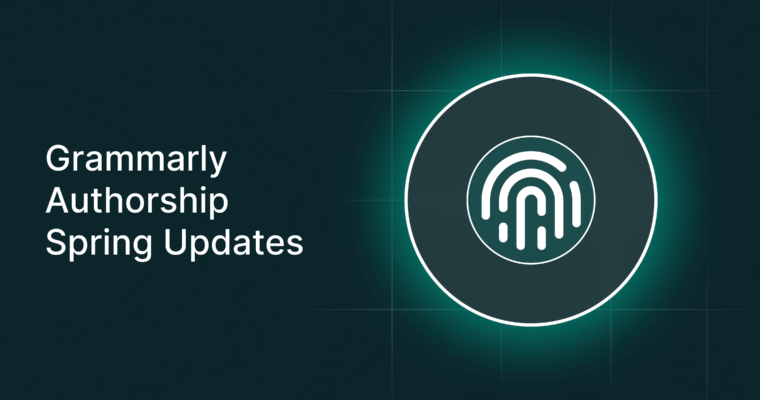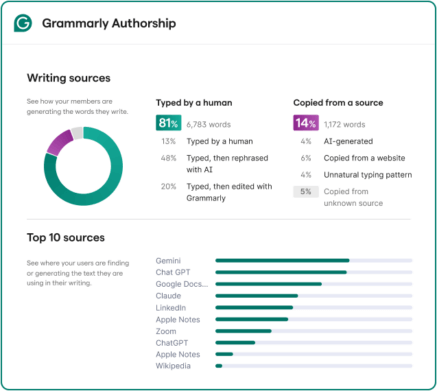
At Grammarly, we aim to empower individuals to communicate effectively and authentically. As artificial intelligence (AI) tools become more integrated into educational settings, maintaining academic integrity has become increasingly complex. To address this, we introduced Grammarly Authorship—a tool designed to provide transparent AI attribution in student writing. Initially launched in beta for Google Docs, we are excited to announce that Grammarly Authorship is now available in Microsoft Word and comes with institutional analytics for Grammarly for Education customers, extending its benefits to a broader audience.
The challenge: Navigating AI in education
The widespread adoption of AI tools has transformed the educational landscape, offering students new avenues for learning and expression. In certain settings, AI may be welcomed as a powerful tool to enhance student learning when appropriately used by students. However, the ability to assess whether or not students are, in fact, using these tools to enhance learning rather than offload it has been very difficult to date.
Traditional AI detection methods often operate opaquely, leading to potential misunderstandings and a trust deficit between students and educators. Students may be uncertain about how their use of AI tools is perceived, while educators may struggle to discern the originality of student work. Even well-intentioned students lack true guardrails or personalized insights to know when they may have outsourced too much of their critical and creative thinking to AI. This environment underscores the need for transparent solutions that clarify the role of AI in the writing process.
Introducing Grammarly Authorship
Grammarly Authorship bridges the gap between AI assistance and academic integrity. Unlike conventional AI detectors that attempt to infer the origin of text post-creation, Authorship proactively tracks and categorizes text during the writing process. It identifies whether content was typed by the student, generated by AI, or copied from external sources. This real-time tracking fosters a transparent writing environment, enabling students to demonstrate the authenticity of their work and educators to gain clear insights into the composition process.
Key features of Grammarly Authorship
- Real-time text source tracking: Authorship monitors the writing process as it unfolds, categorizing text based on its origin—typed by the user, generated by AI, or pasted from external sources.
- Detailed Authorship reports: Upon completion of a document, Authorship generates comprehensive reports that provide insights into the composition of the text, including the percentage of human-written versus AI-generated content. These reports serve as a transparent record that students can share with educators to demonstrate the originality of their work.
- New for April 2025: Authorship tracking in Word—Authorship tracking in Microsoft Word via the Grammarly desktop application provides detailed attribution for text copied from desktop sources, whether desktop AI applications or merely notes from traditional apps that students use to keep track of their work.
- New for April 2025: Speedy citations—Students on Pro and Grammarly for Education plans can see all of their external sources automatically attributed in the detailed report, complete with a “speedy citation” that allows them to copy pre-formatted citations from the source with one click.
- New for April 2025: AI and plagiarism detection—Students on Pro and Grammarly for Education plans will see AI and plagiarism detection flags in the body of their Authorship reports. While these insights are duplicative when Authorship is on, the inclusion of AI and plagiarism detection provides more comprehensive checks for students before they submit in case Authorship did not categorize certain text, allowing them to fix any unintentional plagiarism of sources that may have been typed, but use other sources or resemble AI-generated text.
- Authorship replay: This feature allows users to replay the document’s creation process, offering a step-by-step view of how the text was developed and edited. It provides educators with a deeper understanding of the student’s writing journey, facilitating more informed assessments.
- New for April 2025: Authorship analytics—Grammarly for Education customers will now see aggregated analytics across all Authorship tracking instances, showing the amount of total text that is typed, copied from a known source, and AI generated. Admins will also be able to see the top 10 sources that users are pulling into their writing, including AI sources.
- Note—Analytics will only populate within the Grammarly admin panel once at least 5 users have turned on Authorship tracking.

Benefits for students and educators
- For students: Authorship empowers students to showcase the authenticity of their work, providing a transparent record of their writing process. It also offers insights into their own writing habits, promoting self-awareness and growth in their own use of AI and in their own writing improvement.
- For educators: Authorship equips educators with clear, objective data on the origins of student submissions. This transparency facilitates more productive conversations about AI usage and academic integrity, moving beyond suspicion to constructive dialogue.
“From introducing Grammarly with its own AI detection and Authorship, we went from 27 academic integrity violations to one. It opened up more transparent conversations with students. That’s one of the biggest wins we’ve had here recently. It wasn’t a tool used to catch students—it was a tool to make students responsible.”
-Dr. Jenny Billings, Rowan-Cabarrus Community College
Commitment to privacy and security
At Grammarly, user privacy and data security are paramount. Authorship is an opt-in feature, ensuring users have complete control over its activation. All data is processed with stringent security measures, and users can preview reports before sharing them, maintaining transparency and trust.
Future developments and feedback
As we continue to refine Grammarly Authorship, we welcome feedback from our users to inform future enhancements. Our commitment is to provide tools that support responsible AI use and uphold academic integrity. We look forward to evolving Authorship to meet the needs of our diverse user base.
Conclusion
The integration of AI in education necessitates tools that promote transparency and trust. Grammarly Authorship represents a significant step forward in this endeavor, providing students and educators with the means to navigate AI-assisted writing responsibly. With its expansion to Microsoft Word, we invite more users to experience the benefits of Authorship and join us in fostering a culture of integrity in academic writing.






